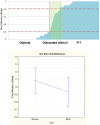Women are better at seeing faces where there are none: an ERP study of face pareidolia
- PMID: 27217120
- PMCID: PMC5015812
- DOI: 10.1093/scan/nsw064
Women are better at seeing faces where there are none: an ERP study of face pareidolia
Abstract
Event-related potentials (ERPs) were recorded in 26 right-handed students while they detected pictures of animals intermixed with those of familiar objects, faces and faces-in-things (FITs). The face-specific N170 ERP component over the right hemisphere was larger in response to faces and FITs than to objects. The vertex positive potential (VPP) showed a difference in FIT encoding processes between males and females at frontal sites; while for men, the FIT stimuli elicited a VPP of intermediate amplitude (between that for faces and objects), for women, there was no difference in VPP responses to faces or FITs, suggesting a marked anthropomorphization of objects in women. SwLORETA source reconstructions carried out to estimate the intracortical generators of ERPs in the 150-190 ms time window showed how, in the female brain, FIT perception was associated with the activation of brain areas involved in the affective processing of faces (right STS, BA22; posterior cingulate cortex, BA22; and orbitofrontal cortex, BA10) in addition to regions linked to shape processing (left cuneus, BA18/30). Conversely, in the men, the activation of occipito/parietal regions was prevalent, with a considerably smaller activation of BA10. The data suggest that the female brain is more inclined to anthropomorphize perfectly real objects compared to the male brain.
Keywords: ERPs; face processing; perception; sex differences; social cognition.
© The Author (2016). Published by Oxford University Press. For Permissions, please email: journals.permissions@oup.com.
Figures








References
-
- Candidi M., Stienen B.M., Aglioti S.M., de Gelder B. (2015). Virtual lesion of right posterior superior temporal sulcus modulates conscious visual perception of fearful expressions in faces and bodies. Cortex, 65, 184–94. - PubMed
Publication types
MeSH terms
LinkOut - more resources
Full Text Sources
Other Literature Sources

